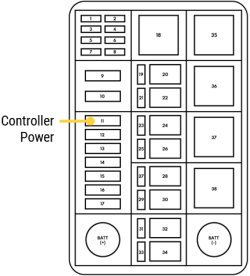Generator Controller
| Problem | Items to Check, Troubleshooting Steps, Remedies |
|---|---|
|
No power-up |
Ensure the control power disconnect switch on the Check the fuse that provides power to the generator controller (Position Verify that the battery connections are secure and that the battery voltage is Check the corresponding wire and terminal connections at the back of the fuse panel. Check the battery power connections at the back of the generator controller, terminals 2 |
|
LCD display is faint and slow to respond |
This can occur to the generator controller if the ambient temperature falls below -20°C (e.g. if the generator unit has been stored outside in temperatures at or below -20°C, the controller display will exhibit this behavior). |
|
Controller is in ‘Editor Mode’ |
The editor mode should not be accessed without direction from (Undefined variable: General.CompanyName) |
|
Electrical trip - Overload |
The generator has been subjected to an excessive load above the threshold configured in the generator controller for the allowable time limit. The generator controller will perform an electrical trip followed by an engine shutdown. A pre-alarm warning will be activated before the electrical trip occurs. Possible causes:
Remedies:
|
|
Electrical trip – High inlet air temperature |
The inlet air temperature has reached or exceeded the threshold configured in the generator controller, and has caused an electrical trip. The main contactor is opened and the engine goes through a cool-down period prior to shutting down. Possible causes:
Items to check:
|
|
Electrical trip – Overcurrent |
The generator current has reached or exceeded the maximum threshold for the allowable time limit. Possible causes:
Ensure that the load is appropriate for the generator. Motors typically require three times their rated current when starting. |
|
Electrical trip – Bus not live |
The generator controller has not been able to measure or verify the bus voltage after closing the contactor, and has caused an electrical trip. Possible causes:
|
|
Electrical trip – Undervoltage |
The generator output voltage has reached or fallen below the threshold configured in the generator controller, and has caused an electrical trip. Possible causes:
Remedies:
|
|
Electrical trip – Underfrequency |
The frequency of the generator has reached or fallen below the threshold configured in the generator controller, and has caused an electrical trip. Possible causes:
Remedies:
Manufacturers’ procedures:
NOTE When the generator is closed onto the BUS, the generator controller can control the engine governor and make quick adjustments to help maintain and recover engine speed in response to changes in the load. If an excessive load is applied to the generator, the generator controller's adjustment of the governor may not be enough for the engine to recover before an underfrequency electrical trip occurs. |
 Ensure the controller power switch below the controller is turned on.
Ensure the controller power switch below the controller is turned on. If the generator controller is in ‘Editor Mode’, press and hold the checked button to exit and return to normal user mode (hold the checked button for approximately 3 seconds).
If the generator controller is in ‘Editor Mode’, press and hold the checked button to exit and return to normal user mode (hold the checked button for approximately 3 seconds).